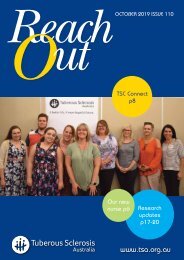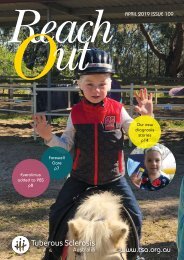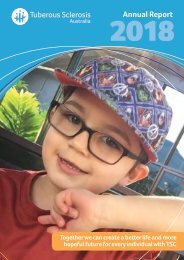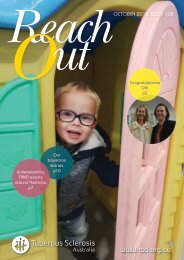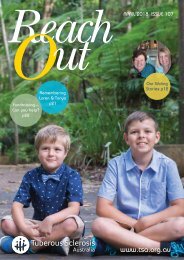Tuberous Sclerosis Australia Reach Out Magazine October 2016
Create successful ePaper yourself
Turn your PDF publications into a flip-book with our unique Google optimized e-Paper software.
Information<br />
Information<br />
Lachlan, QLD<br />
Oliver, NSW<br />
Hamish<br />
Matilda, VIC<br />
How does knowing about these higher risk periods of<br />
time help parents and carers?<br />
For all the parents of small babies with TSC, I explain what a<br />
subtle seizure or epileptic spasm looks like. Around those periods<br />
of higher risk for the baby (see above) we go back through that<br />
information, particularly if the EEG is starting to show some signs<br />
of being abnormal. Parents capturing video of events of concern<br />
is the most important thing at that time. Videos can be sent to<br />
neurologists who can review them rapidly and provide reassurance<br />
or arrange rapid assessment if the events are confirmed to be a<br />
seizure. Obtaining this rapid support for events of concern is one<br />
of the most important things for infants with TSC in these risky<br />
time windows. While I understand the urge to put TSC in the<br />
background and get on with life, I think that being over-anxious is<br />
probably better than being under-anxious when it comes to these<br />
early seizures in the life of an infant with TSC as early action is<br />
important for the best outcome.<br />
What are the challenges in rolling out this new<br />
approach to all infants with TSC?<br />
High frequency EEGs in early life for infants with TSC who have<br />
not yet had clinical seizures is a very resource intensive process.<br />
I can be seeing some babies every week or fortnight for an EEG.<br />
A lot of centres would not have the ability to provide that service<br />
given funding for EEG services. However a long term view of this<br />
resourcing is important, as if we provide this resource intense<br />
service early, and see these babies early on frequently, we can<br />
potentially make an important difference to the frequency of long<br />
term seizures and to their developmental outcome and this means<br />
that once the infant is 3 years of age and older, that child will not<br />
be a frequent attender in complex epilepsy clinics and requiring<br />
heavy lifelong support from hospital and health and care services.<br />
The trend that is emerging at our centre is that I am seeing these<br />
babies very intensively up until the age of 2 to 3 years of age and<br />
then only seeing them yearly after that. We’ve only been doing this<br />
new approach of EEG surveillance since 2011 so we still have more<br />
to learn about the approach on whether there is a long term benefit<br />
and how great this is.<br />
General principles from other<br />
epilepsies are...relevant to understanding<br />
why early treatment of an active tuber,<br />
identified on EEG is important.<br />
What are the implications of this approach for general<br />
epilepsy, outside of TSC?<br />
That’s a good question. This idea of controlling the EEG is new to<br />
epilepsy in general. We’ve always focused on the clinical seizures.<br />
We increasingly realise that clinical seizures are just the worst<br />
manifestation of abnormal biology in the brain and it is this<br />
abnormal biology that has enormous impact on quality of life,<br />
development, behaviour and sleep. So this principle of ‘clinical<br />
seizures are not everything’ is very important for other epilepsies.<br />
TSC has some characteristics that are unique from other causes<br />
of epilepsy that make this approach particularly suitable. We<br />
know that the majority of babies with TSC will have epilepsy; we<br />
know that the EEG will, fairly reliably, predict the onset of clinical<br />
seizures; and we have the potential to prevent the brain developing<br />
very complex and difficult to control epilepsy. This is in contrast<br />
to other groups at risk of seizures, such as babies that have had a<br />
stroke. For this group there is a smaller percentage of babies that<br />
will go on to develop seizures, and these seizures are much more<br />
likely to be controlled with a single medication.<br />
General principles from other epilepsies are, however, relevant<br />
to understanding why early treatment of an active tuber, identified<br />
on EEG is important. There is a concept that is known from<br />
general epilepsy, that ‘seizures beget seizures’. We’ve known for<br />
some time that if you’ve got ongoing abnormal electricity in part of<br />
the brain that this recruits wider and wider areas and seizures then<br />
come from the whole brain or other areas of the brain. Once this<br />
whole brain recruitment has occurred, it is harder to wind seizures<br />
down again with anti-convulsant medications. The new approach<br />
of EEG surveillance for infants with TSC is a very clear model of<br />
managing this: essentially we catch seizure-generating tubers on<br />
an EEG very early and treating before they start recruiting other<br />
areas of the brain so that there is better overall epilepsy control or<br />
remission of seizures.<br />
What advice would you give to parents of a new baby<br />
with TSC?<br />
From a medical perspective, I encourage people to ensure they<br />
have access to a paediatric neurologist with an interest in TSC.<br />
This could be their doctor, or someone their doctor can link in<br />
with when needed for support and advice.<br />
There has been incredible progress in TSC in the last 20 years.<br />
We only discovered the genetic changes that cause TSC in the 1990s<br />
and the pathways that these influence not long after that. Our<br />
knowledge of ways that we can positively influence the condition is<br />
increasing rapidly. I usually highlight that most of the information<br />
on the internet is out of date and that this can be unnecessarily<br />
alarming. I always emphasise that TSC is a highly individual<br />
condition and that every individual with TSC is an individual.<br />
I try to tell my new families balanced information about<br />
current data from our clinic, which reflects some of the newer<br />
treatments, early access to EEG surveillance (from 2011),<br />
early access to curative epilepsy surgery and access to mTOR<br />
inhibitors. I give information that is balanced about current<br />
rates of epilepsy and intellectual disability in our modern TSC<br />
cohort. I have teenagers in our clinic who are school captains<br />
and some have high IQs, and will transition to university. It has<br />
a very diverse impact but in our clinic at this time, the rate of<br />
intractable epilepsy is low (14% of our cohort currently) and<br />
this likely reflects better and more intense therapy in early life.<br />
The best information is therefore obtained from people who are<br />
familiar with TSC and this often helps allay anxiety that can<br />
escalate when the internet is accessed.<br />
Editor’s note - This approach to treating epilepsy in TSC is available<br />
at many centres around <strong>Australia</strong>. The availability of EEG testing,<br />
particularly in regional areas, is one barrier to more widespread use of<br />
this intensive monitoring protocol. For help finding a neurologist with<br />
experience treating TSC you can contact the TSC Information Service<br />
by emailing info@tsa.org.au or calling 1300 733 435.<br />
1. Jozwiak, S., et al., Antiepileptic treatment before the onset of<br />
seizures reduces epilepsy severity and risk of mental retardation<br />
in infants with tuberous sclerosis complex. Eur J Paediatr Neurol,<br />
2011. 15(5): p. 424-31.<br />
2. Wu, J.Y., et al., Clinical Electroencephalographic Biomarker for<br />
Impending Epilepsy in Asymptomatic <strong>Tuberous</strong> <strong>Sclerosis</strong> Complex<br />
Infants. Pediatr Neurol, <strong>2016</strong>. 54: p. 29-34.<br />
3. Muzykewicz, D.A., et al., Infantile spasms in tuberous sclerosis<br />
complex: prognostic utility of EEG. Epilepsia, 2009. 50(2):<br />
p. 290-6.<br />
4. Domanska-Pakiela, D., et al., EEG abnormalities preceding the<br />
epilepsy onset in tuberous sclerosis complex patients - a prospective<br />
study of 5 patients. Eur J Paediatr Neurol, 2014. 18(4): p. 458-68.<br />
16<br />
<strong>Reach</strong><br />
<strong>Out</strong><br />
OCTOBER <strong>2016</strong> ISSUE 104<br />
17





![TSA Reach Out April 2022 [Final]](https://documents.yumpu.com/000/066/687/587/3d369bd665bdb406a759500f62e2cfad0ccb7b3d/47512b4a703265727550565249426664566a727454513d3d/396a524e7354316d3867454b587243526164724c52673d3d.jpg?AWSAccessKeyId=AKIAICNEWSPSEKTJ5M3Q&Expires=1714377600&Signature=Vz2OGG9G2tFN4kIQy3GSH9rSHMY%3D)
![TSA AR 2021 [WEB] (1)_FINAL](https://documents.yumpu.com/000/065/886/431/1afb21934ac6c444cd384e5fd7403d62e47080ce/426853747566526573646568546777594b4a4a5734513d3d/547274595943503850786275754544495972536c52513d3d.jpg?AWSAccessKeyId=AKIAICNEWSPSEKTJ5M3Q&Expires=1714377600&Signature=UJ4b68j6DAm8wZt5gP9ZK2%2F0tbU%3D)

![TSA Reach Out Apr 2021 [WEB]](https://documents.yumpu.com/000/065/442/909/1e583cb2acba0eaa7f1aae53e14a0cf408aa56c4/7871796d694459464d707163324830746459484671673d3d/45356637637a3369494f764f4c3858495549795251513d3d.jpg?AWSAccessKeyId=AKIAICNEWSPSEKTJ5M3Q&Expires=1714377600&Signature=Yp5hoDEEJrIbuxg952296BmMYAk%3D)




